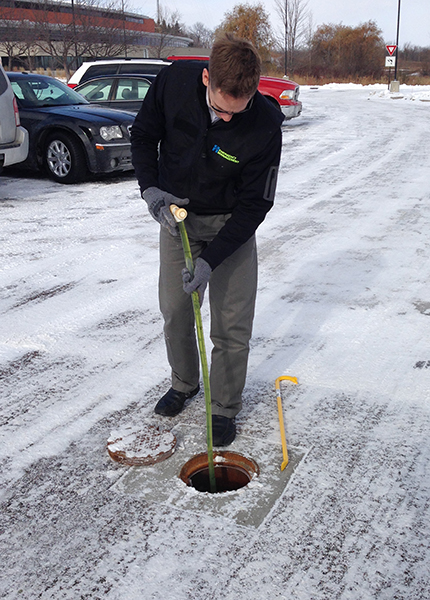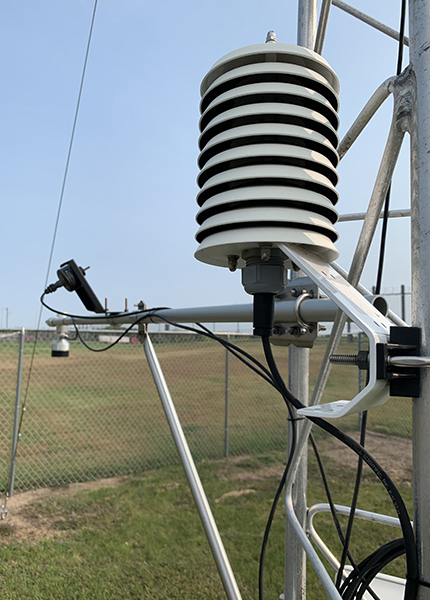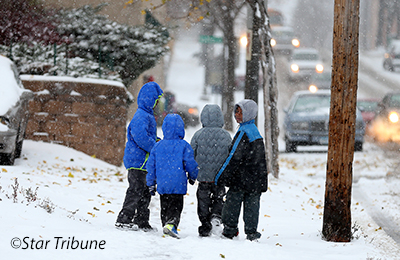New, local data helps combat winter weather hazards
 The county is using weather data to detect potential hazards like frozen water mains, spring flooding and icy roads.
The county is using weather data to detect potential hazards like frozen water mains, spring flooding and icy roads.
Hennepin County Emergency Management measures local frost depth and freezing rain, which can sometimes be the culprit of these issues. Staff gather measurements at seven county locations weekly in the winter.
Monitoring frost depth
Preventing utility issues
Emergency management measures frost depth to understand potential impacts on underground utilities.
Frost depth is usually more of a problem under pavement. When pavement is cleared, cold air has more opportunity to freeze the ground below. Water mains are also under pavement, most of them eight feet underground.
When frost reaches seven feet underground, cities scrutinize frost depth readings and watch water mains for breaks.
If frost reaches eight feet underground, water main breaks are much more likely. This is because freezing water expands and shifts the soil, putting pressure on water mains.
Ways you can prevent a water main break
- Leave snow on pavement when possible. This could reduce frost depth and decrease the chances of water main break.
- Find out if your home has had previous issues with water lines freezing.
- Track the frost depth in your area.
- If frost is deeper than eight feet, prevent frozen water lines by running a pencil width of water in faucets.
Forecasting spring flooding
Emergency management also monitors frost depth to forecast spring flooding. Flood risk depends on how much snow runs off or soaks into the ground.
There is a high flood risk with deep frost, heavy snowpack and warm temperatures. This can cause snow to run off into rivers, streams and lakes and flood them.
When temperatures slowly rise in the spring, moisture trickles into the ground. This can help drought conditions.
Detecting freezing rain to keep transportation moving
 Freezing rain can be detrimental to transportation, public works and public safety.
Freezing rain can be detrimental to transportation, public works and public safety.
For example, Metro Transit powers light rail trains using a copper wire above the rail. Crews use a scraper to keep freezing rain off the wire and keep power flowing.
Metro Transit used to guess when freezing rain was occurring and scraped the wire too often. This caused more damage to the expensive wire.
After the county installed a freezing rain sensor, Metro Transit now only scrapes the wire when sensors detect freezing rain. This saves time, energy and money.
The Hennepin County freezing rain data is also helping:
- Public works departments identify when roads need to be de-iced. This is important to help police, fire and EMS respond to emergency calls.
- Airports identify when de-icing is needed for runways or planes.
- Utility companies prepare for potential icing on power lines that could disrupt services.
- The National Weather Service understand forecasts, issue warnings and track ice accumulations.
Understanding climate impacts
To draw any long-term conclusions about climate, we will need a climate record, which is at least 30 years of data. We don't have that data yet, but Meteorologist Emily Harrington with Hennepin County Emergency Management has some predictions.
"Generally, climate change is causing more extreme weather and higher annual temperatures. With these assumptions, frost might not go as deep in the ground year after year. Shallower frost depth will not help drought conditions. It could also create more groundwater flooding caused by winter storms, due to the ground being warmer."
"Freezing rain could become more frequent and hazardous," Harrington continued. "Freezing rain events are very difficult to forecast and even harder to mitigate. By maintaining and expanding our mesonet network, we will understand how our climate is changing."
View current weather data
- See all weather data that Hennepin County collects including data on frost depth and freezing rain.


